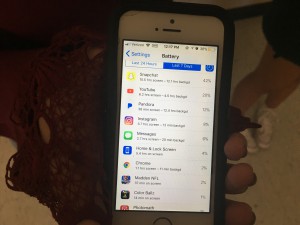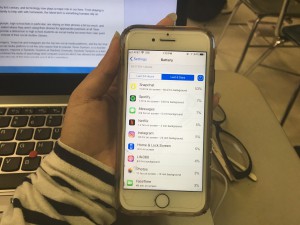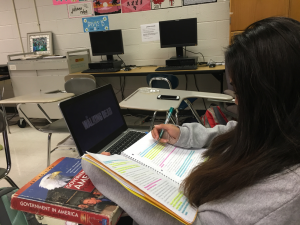It’s the 21st century, and technology now plays a major role in our lives. From staying in touch with family to help with homework, the latest tech is something humans rely on everyday.
But now, people, high school kids in particular, are relying on their phones a bit too much, and it’s to the extent where they aren’t using their phones for appropriate purposes at all. Now, phones provide a distraction to high school students as social media becomes their main point of focus instead of their classes.
For teenagers, Snapchat and Instagram are a couple of the most popular social media platforms, and the fact that it is a social media platform is not the only reason that it’s popular.

Francine Simbulan, a sophomore at Leesville Road High School and a phone addict, prefers Instagram. “[For me] Instagram [is better], because it’s sort of an outlet for letting people see where you are and what you’re up to.”
Although Simbulan prefers Instagram, she thinks Snapchat is more distracting. “People are always snapping me and I always get two to three notifications from [Snapchat] whenever I’m on my phone.” Those two to three notifications, as minimal as they might seem, can completely side track a student’s thought process, as it takes an average of twenty- five minutes to return to an original task after an interruption.
Zachary Burgess, a sophomore at Leesville Road High School, also believes that Snapchat is more distracting. “People will always snap me while I’m doing my work, and I won’t be able to get it done because I’ll be distracted.”
Social media addiction is nothing any teenager of the 21st century has not heard of. But there’s a certain science behind social media and the corresponding addiction that comes with it, and this doesn’t apply to teenagers only. In fact Facebook, Twitter, and Linkedin are three huge social media platforms for adults.
But think about the Facebook, Twitter and Linkedin icons. Notice anything similar about them? It’s the color blue, which is known for representing intellect, and in the growing world, communication. This ideology is known as color psychology, and it’s one of the reasons why adults and teenagers alike are drawn into certain social media apps.
On February 9, 2009, Facebook launched a new feature: the like button. As the first of its kind, the “like: button was an innocent feature, but it would largely contribute to “the attention economy.” “The attention economy” has been known as the demand for a person’s attention. For most people, social media platforms allow for friends and family to “like” a picture, creating a sense of validation. This sense of validation creates a short burst of happiness that makes us want to scroll more and return more often to the platform.

Another piece of psychology linked to social media addiction is something called “social reciprocity,” which is similar to social feedback. Psychologists describe it as if someone pats your back or gives you a high five. When you receive a high five, or any other physical encouragement, you feel the pressure of the high five against your palm. Social media uses this when they alert you that someone has received your message. In addition, it makes the receiver want to respond, and at the same time, it encourages you to check back frequently for the response. Apple in iMessage also uses social reciprocity, when those three dots pop up when your acquaintance is responding.
For teenagers Snapchat remains a highly addictive app, and the main reason for that is streaks. You create a streak when you send a snap to another person for a number of consecutive days. In order to maintain a streak, you have to snap the recipient every day, which by itself, keeps snapchatters returning day after day. For most teenagers, streaks validate a friendship, and streaks validate a friendship between two social media acquaintances. This plays a huge role in social acceptance because the more streaks you have, the more friends you have, which makes you more “popular.”
In this day and age, social media plays a huge part in our lives. It first started with Facebook as the thumbs-up button was introduced, which heightened our need for social validation. As the number of social platforms increased, so did “the attention economy” for both teenagers and adults. Colors also attract people, and have been proved to aid in the temptation. These factors combined provide a distraction which can be lethal to students and their minds.

Leave a Reply